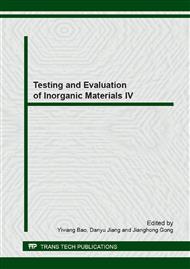[1]
T.K. Gupta, Application of zinc oxide varistors, J. Am. Ceram. Soc. 73 (1990) 1817-1840.
Google Scholar
[2]
S. Shichimiya, M. Yamaguchi, N. Furuse, M. Kobayashi, S. Ishibe, Development of advanced arresters for GIS with new zinc-oxide elements, IEEE T. Power Delivery 13 (1998) 465–471.
DOI: 10.1109/61.660916
Google Scholar
[3]
T. Imai, T. Udagawa, H. Andoh, Development of high gradient zinc oxide nonlinear resistors and their applications to surge arresters, IEEE T. Power Delivery 13 (1998) 1182–1187.
DOI: 10.1109/61.714482
Google Scholar
[4]
K. Mukae, Zinc-oxide varistors with praseodymium oxide, Am. Ceram. Soc. Bull. Vol. 66 (1987) 1329-1331.
Google Scholar
[5]
S. Fujitsu, H. Toyoda, H. Yanagida, Origin of ZnO varistor, J. Am. Ceram. Soc. 70 (1987) C71-C72.
Google Scholar
[6]
H.H. Hng, K.Y. Tse, Grain growth of ZnO in binary ZnO-V2O5 ceramics, J. Mater. Sci. 38 (2003) 2367-2372.
Google Scholar
[7]
J.P. Han, A.M.R. Senos, P.Q. Mantas, Varistor behaviour of Mn-doped ZnO ceramics, J. Eur. Ceram. Soc. 22 (2002) 1653-1660.
DOI: 10.1016/s0955-2219(01)00484-8
Google Scholar
[8]
S. Bernik, N. Daneu, Characteristics of ZnO-based varistor ceramics doped with Al2O3, J. Eur. Ceram. Soc. 27(2007) 3161-3170.
DOI: 10.1016/j.jeurceramsoc.2007.02.176
Google Scholar
[9]
C.W. Nahm, Improvement of electrical properties and aging characteristics of Pr-Co-Cr-Y- modified ZnO varistor by Al2O3 doping, Mater. Sci. Eng. 151B (2008) 146-151.
DOI: 10.1016/j.mseb.2008.05.023
Google Scholar
[10]
C.W. Nahm, Microstructure and electrical properties of Al2O3–doped ZPCCYA-based varistors, Mater. Lett. 62 (2008) 2900-2903.
DOI: 10.1016/j.matlet.2008.01.068
Google Scholar
[11]
D.R. Clarke, Varistor ceramics, J. Am. Ceram. Soc. 82 (1999) 485-502.
Google Scholar
[12]
C.W. Nahm, The effect of sintering temperature on electrical properties and accelerated aging behavior of PCCL-doped ZnO varistors, Mater. Sci. Eng. 136B (2007) 134-139.
DOI: 10.1016/j.mseb.2006.09.010
Google Scholar
[13]
S.Y. Chun, N. Mizutani, Mass transport via grain boundary in Pr-based ZnO varistors and related electrrcal effects, Mater. Sci. Eng. 79B (2001) 1-5.
DOI: 10.1016/s0921-5107(00)00552-3
Google Scholar
[14]
K. Mukae, T. Tsuda, I. Nagasawa, Non-ohmic properties of ZnO-rare earth metal oxide-Co3O4 ceramics, Jpn. J. Appl. Phys. 16 (1977) 1361-1368.
DOI: 10.1143/jjap.16.1361
Google Scholar
[15]
C.W. Nahm, Microstructure and electrical properties of Tb-doped zinc oxide-based ceramics, J. Non-Crystall. Solids 353 (2007) 2954-2957.
DOI: 10.1016/j.jnoncrysol.2007.06.041
Google Scholar
[16]
C.W. Nahm, Nonlinear electrical properties and stability of Zn-Pr-Co-Er-M (M=Ni, Mg, Cr) oxide-based varistors, J. Mater. Sci. 41 (2006) 1635-1638.
DOI: 10.1007/s10853-005-2185-3
Google Scholar
[17]
H.H. Hng, K.M. Knowles, Microstructure and current-voltage characteristics of praseodymium- doped zinc oxide varistors containing MnO2, Sb2O3 and Co3O4, J. Mater Sci. 37 (2002) 1143-1154.
Google Scholar
[18]
T. Ogasawara, R. Tanaka, K. Sugawara, T. Sugawara, Effect of the additives on the nonlinear coefficient of ZnO varistor. J. Ceram. Soc. Jpn. 108 (2000) 565-570.
DOI: 10.2109/jcersj.108.1258_565
Google Scholar
[19]
H. Feng, Z.J. Peng, X.L. Fu, et al., Effect of TiO2 doping on microstructural and electrical properties of ZnO-Pr6O11-based varistor ceramics, J. Alloys Compd. 497 (2010) 304-307.
DOI: 10.1016/j.jallcom.2010.03.047
Google Scholar
[20]
H. Feng, Z.J. Peng, X.L. Fu, et al., Effect of SnO2 doping on microstructural and electrical properties of ZnO-Pr6O11 based varistor ceramics, J. Alloys Compd. 509 (2011) 7175-7180.
DOI: 10.1016/j.jallcom.2011.04.042
Google Scholar
[21]
X.F. Cheng, W.H. Leng, D.P. Liu, et al., Enhanced photoelectrocatalytic performance of Zn-doped WO3 photocatalysts for nitrite ions degradation under visible light, Chemosphere 68 (2007) 1976-(1984).
DOI: 10.1016/j.chemosphere.2007.02.010
Google Scholar
[22]
M. Hibino, W. Han, T. Kudo, Electrochemical lithium intercalation into a hexagonal WO3 framework and its structural change, Solid State Ionics 135 (2000) 61-69.
DOI: 10.1016/s0167-2738(00)00332-5
Google Scholar
[23]
S.T. Li, F.Y. Liu, X.L. Song, Functional additives in ZnO varistor ceramics, J. Ceram. 18 (1997) 73-77.
Google Scholar
[24]
C.W. Nahm, B.C. Shin, B.H. Min, Microstructure and electrical properties of Y2O3-doped ZnO-Pr6O11-based varistor ceramics, Mater. Chem. Phys. 82 (2003) 157-164.
DOI: 10.1016/s0254-0584(03)00213-x
Google Scholar
[25]
Z.J. Peng, X.L. Fu, Y.X. Zang, et al., Influence of Fe2O3 doping on microstructural and electrical properties of ZnO-Pr6O11 based varistor ceramic materials, J. Alloys Compd. 2010, 508(2): 494-499.
DOI: 10.1016/j.jallcom.2010.08.100
Google Scholar
[26]
M.E. EI-Dahshan, D.P. Whittle, J. Stringer, The oxidation of cobalt-tungsten alloys, Corros. Sci. 16 (1976) 77-82.
DOI: 10.1016/0010-938x(76)90032-9
Google Scholar
[27]
A. Cavaleiro, M.T. Vieira, Characterization of a sputtered amorphous W-C-Co coating annealed in air, Thin Solid Films 228 (1993) 80-86.
DOI: 10.1016/0040-6090(93)90569-b
Google Scholar
[28]
S. Rajagopal, D. Nataraj, O. Yu Khyzhun, et al., Hydrothermal synthesis and electronic properties of FeWO4 and CoWO4 nanostructures, J. Alloys Compd. 493 (2010) 340-345.
DOI: 10.1016/j.jallcom.2009.12.099
Google Scholar
[29]
M. Imura, T. Tanaka, M. Homma, M. Okada, Nonlinear current-voltage characteristics of double-layered ZnO/RxOy (R=La, Ce, Pr, Nd) sputtered films, Mater. Trans. 35 (1994) 730-734.
DOI: 10.2320/matertrans1989.35.730
Google Scholar


